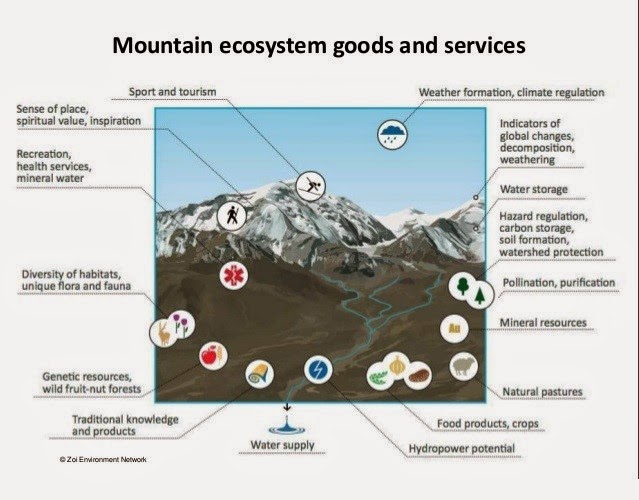When one talks about Goods and Services, everyone understand. Although, when I speak about Ecosystem Goods and Services, a big question mark generally appears in my interlocutor’s face.
In short, the term ecosystem refers to the combined physical and biological components of an environment. These organisms form complex sets of relationships and function as a unit as they interact with their physical environment (WHO).
Ecosystem Goods and Services are the benefits people obtain from ecosystems, often for free. These include provisioning services such as food and water; regulating services such as flood, weather and disease control; cultural services (non-material benefits) such as spiritual, recreational, and cultural benefits; and supporting services such as nutrient cycling that maintain the conditions for life on Earth.
These Goods and Services are essential for human well-being and survival. Therefore, when we impact our ecosystems, we consequently impact our well-being.
The Millinium Assessment provides a Conceptual Framework of how human well being and health is impacted by changes in ecosystems, at local, regional, and global scales.
 |
The demand for ecosystem services is now so great that trade-offs among services have become the rule. A country can increase food supply by converting a forest to agriculture, for example, but in so doing it decreases the supply of services that may be of equal or greater importance, such as clean water, timber, ecotourism destinations, or flood regulation and drought control.
The problem posed by the growing demand for ecosystem services is compounded by increasingly serious degradation in the capability of ecosystems to provide these service. This is particularly true when dealing with mountain environments.
This is also why I was really interested in learning more about the Nursery Project as Ghandruk is located in a mountain region. Mountain regions are characterized by sensitive ecosystems, enhanced occurrences of extreme weather events, and natural catastrophes such as land slides and floodings or such as the recent avalanche at the Thorung La pass.
This project addresses tree obvious objectives directly linked to the management of difficult environment such as mountain and alpine ecosystems. The first objective being to ensure timber for construction, fuel for cooking and forge plants for buffalo and oxen. Insuring the availability of such plants and schrubs helps reducing soil erosion due to a combination of intense grazing and important precipitations during monsoon’s seasons. Finally, the third objective aims at maintaining and improving the Biodiversity through the growing of rare and endangered species according to IUCN red list.
Sadly, the greenhouse build for the purpose of maintaining Biodiversity through critically endangered tree and schrub species planting was destroyed during last monsoon's season (July & August 2014).
.JPG) |
| Seasonal needs for goods and services are directly linked to tourism |
 |
| Ever wondered how Tea Houses and Hotels can provide food at such altitudes as the 4130 m of the ABC |
Often regarded as hostile and economically nonviable regions, mountains have attracted major economic investments for tourism. We can simply look at the Canadian Rockies or the French Alps to predict the issues places like the Annapurna Conservation Area might be facing in the near-future. The projected amplitude and rate of climatic change in coming decades is likely to lead to significant perturbations of natural systems as well as the social and economic structure of mountain societies, particularly where these are marginal.
Because in many instances mountains and uplands are regions of conflicting interests between economic development and environmental conservation, shifts in climatic patterns probably will exacerbate the potential for conflict. Sadly, this story seems to repeat itself over and over again around the world.
The daily life of Ghandruk communities is closely linked to seasonal cycles both in terms of agriculture and tourism industry which in turn, is under the influence of weather's whims.
As a major ecosystem representing the complex and interrelated ecology of our planet, mountain environments are essential to the survival of the global ecosystem.
Mountain ecosystems are, however, rapidly changing. They are susceptible to accelerated soil erosion,landslides and rapid loss of habitat and genetic diversity. On the human side, there is widespread poverty among mountain inhabitants and loss of indigenous knowledge. As a result, most global mountain areas are experiencing environmental degradation. Hence, the proper management of mountain resources and socio-economic development of the people
deserves immediate action.
deserves immediate action.
I certainly hope that the Annapurna Conservation Area Project (ACAP) will continue to work closely with the communities to reduce the degradation of this beautiful place.

.JPG)


Excellente définition des différentes composantes environnementales. Malheureusement, on trop souvent " soit disant" développé de nombreuses régions en plaçant l'homme au dessus, à part des écosystèmes alors qu'il en fait partie intégrante. J'aime beaucoup le petit tableau synthèse. Mise au point très claire, c'est très bien écrit!
ReplyDeleteJ'ai bien apprécié tes tableaux sur la dynamique des écosystèmes qui constituent des ynthèses ou des plans de cours universitaires.L'Homo sapiens doit s'intégrer dans cette dynamique de facon comprénshive et quantitavive sinon l'écosystème s'appauvri et la survie de l'humain est en danger. Bravo Nivea, tu l'abien démontré. Merci pour les beax paysages, pour les piques de montagnes qui se font caresser par une lumière dorée d'un lever du soleil. Même si je ne réagit pas souvent, je suis tous tes commentaires et photos par Rollande. Bravo et merci. Domingos
ReplyDelete